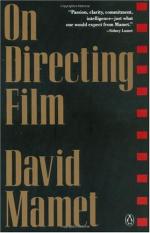
|
| Name: _________________________ | Period: ___________________ |
This test consists of 15 multiple choice questions and 5 short answer questions.
Multiple Choice Questions
1. Mamet says in Chapter 4 that a lot of the decisions you think are going to be arbitrary are arrived at through the what?
(a) Unconscious.
(b) Dreams.
(c) Subconscious.
(d) Consciousness.
2. Mamet says in Chapter 6 that any real what is going to be based on things within your control?
(a) Technique.
(b) Ability.
(c) Craft.
(d) Skill.
3. What was the last beat about in the hypothetical film in Chapter 5?
(a) A man sells a pig.
(b) A man sells a goat.
(c) A man saves the day.
(d) A man rewards a good deed.
4. What do actors erroneously try to use their intellectuality to do?
(a) Create subdramas.
(b) Portray a sense of character.
(c) Show the ending in the scene.
(d) Portray the idea of a movie.
5. What did the pig have around its neck in the hypothetical film from Chapter 5?
(a) A belt.
(b) A leash.
(c) A handkerchief.
(d) A collar.
6. What does Mamet say is the superobjective of the hero in Chapter 6?
(a) The channel.
(b) The buoy.
(c) The river.
(d) The roadside.
7. Who does Mamet say wove flaws into their blankets to let the devil out?
(a) The Navahos.
(b) The Mayans.
(c) The Cherokee.
(d) The Iriquois.
8. The purpose of rehearsal is to tell the actors, beat by beat, what?
(a) The emotions needed.
(b) The objectives.
(c) The characterization.
(d) The actions called for.
9. According to Mamet in Chapter 6, if you persevere, then what method of thinking will become easier for you?
(a) Creative.
(b) Subconscious.
(c) Analytical.
(d) Focused.
10. According to Mamet, under conditions of great stress, you have to know your what?
(a) Camera.
(b) Trade.
(c) Shot.
(d) Craft.
11. Mamet made the analogy in Chapter 4, "if the house is going to stand, the nail must do the work of ____."
(a) A nail.
(b) A hammer.
(c) A beam.
(d) A slat.
12. What was the steamboat captain's answer to Stanislavsky, in Chapter 6?
(a) "I drink a lot of water."
(b) "I stick to the channel; it's marked."
(c) "I use a map."
(d) "I have a sounding beacon."
13. Stanislavsky wrote that the difficult will become easy and the easy habitual, so that the habitual may become what?
(a) Beautiful.
(b) Exact.
(c) Honest.
(d) True.
14. Where was Stanislavsky having dinner with a steamboat captain, according to Mamet in Chapter 6?
(a) The Thames River.
(b) The Volga River.
(c) The Atlantic Ocean.
(d) The Indian Ocean.
15. When the farmer saw the man on the road, how did Mamet refer to this beat?
(a) Gaining a foothold.
(b) Gaining respect.
(c) Selling the animal.
(d) Capitalizing on a golden opportunity.
Short Answer Questions
1. The reply from the person who was asked if they were ever lost was that they were once bewildered for how many days?
2. In Chapter 5, the hypothetical film Mamet worked on with the students involved a farmer selling what?
3. After shooting which take do you not even remember why you were born?
4. According to Mamet in Chapter 6, we would like to learn a technique of directing and analyzing as concrete as that of a what?
5. What does Mamet say is useless filler in film, and the giveaway to a joke's punch line, in Chapter 5?
|
This section contains 496 words (approx. 2 pages at 300 words per page) |

|




